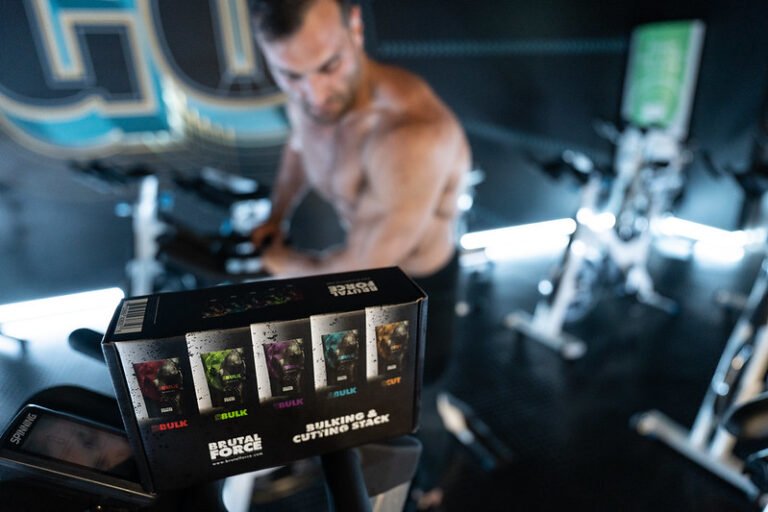Muscle Building Workout Plan To Build Muscle Fast In 2022
Muscle building requires focus – it’s all about consistency, form, and intensity. Getting the right workout plan is the first step to gaining more muscle. We’ll set you up with the best workout for maximum lean mass and provide you with information for getting great results.
When you are in the gym, you should be working toward a very specific outcome: gaining more muscle mass. To do so, your training regimen will need to consist primarily of compound lifts that can sculpt massive amounts of muscle. If you’re ready to get bigger, let’s get started!
Muscle Building Workout Routine
Today is your leg day – the focus is on the quadriceps, hamstrings, and calves. After properly warming up, do the following exercises in order for the recommended sets and repetitions. Be sure to take a rest for 1-2 minutes between your sets for optimal muscle recovery.
DAY 1: LEGS
FREEHAND JUMP SQUAT
Muscle Targeted: Quadriceps
2 sets of 15 reps
WIDE STANCE BARBELL SQUAT
Muscle Targeted: Quadriceps
3 sets of 8-12 reps
NARROW STANCE LEG PRESS
Muscle Targeted: Quadriceps
3 sets of 8-12 reps
LEG EXTENSIONS
Muscle Targeted: Quadriceps
3 sets of 8-12 reps
ROMANIAN DEADLIFT
Muscle Targeted: Hamstrings
3 sets of 8-12 reps
LYING LEG CURLS
Muscle Targeted: Hamstrings
3 sets of 8-12 reps
CALF PRESS ON THE LEG PRESS MACHINE
Muscle Targeted: Calves
3 sets of 8-12 reps
ROCKING STANDING CALF RAISE
Muscle Targeted: Calves
3 sets of 8-12 reps
Keys To Your Workout Success
Geared For Success
Before you start your workout, it is crucial to be prepared. When starting any exercise program, safety is of the utmost importance. Lifting straps, gloves, and lifting belts are some very useful pieces of equipment to have when you are seriously training. Equipment is great for supporting correct form and preventing injury. Put your guard up, and lift smart.
Having the right apparel is also good for working out. You don’t want any uncomfortable chaffing from not having fitness-friendly clothing. Your body should only be concerned with exercising, not with a pair of shorts that are too tight. Wear comfortable gear that allows you to move about and sweat in.
Having a gym bag, lock, and water bottle is also useful – keep your gear secure, and have something to drink so you can stay hydrated! It’s very easy for personal items to “get up and walk away” at gyms, so it’s nice to always have a gym lock and bag to prevent any sticky fingers from nabbing your stuff.
Get A Partner
Lift with a partner whenever possible – someone that can help you with big lifts like bench press or squats, or someone to do your cardio with. A good partner will ensure appropriate form, hold you accountable to your training, assist you in pushing yourself during your last reps, and provide quick inspiration when you need it the most.
If you don’t have a consistent partner, don’t be afraid to ask for a helping hand. The extra reassurance of a spotter will help you surpass personal bests.
Workout partners are everywhere – they could be someone from school, a buddy at the gym, or anyone you know with a similar fitness goal.
Grab a companion that is stronger than you and can push you to your boundaries if you can. This will help you break your boundaries and make progress.
Focus And Form
Focus
Any training program’s success relies heavily on mental preparation. You must leave all distractions outside the gym, including job, stress, money, housework, and fear.
Everyone is going to the gym to improve themselves, so don’t be concerned about people staring at you; most people in the gym stare at each other to stay motivated. Concentrate on yourself, your workout, and your physical condition.
Working out also necessitates a greater level of effort than usual. You might be astonished to learn that if you don’t believe in yourself, you won’t be able to do it. You should mentally or even verbally thank and motivate yourself during each set and exercise.
Every success and failure while training is a step forward, so keep your head in the game, and you’ll notice development.
Form
The form is the most important aspect of training. As you will soon realize, many of the people in the gym have poor form due to lifting too heavy – they’ll have to worry about injuries later.
Remember to check your form in a mirror after each set and rep to ensure it’s correct. You may ensure that your target muscles receive the force they require for growth by focusing on tight form and building a strong mind-muscle connection.
Sets, Reps, And Weight
Sets And Reps
You will hear the terms “rep” and “set” used frequently. A “rep” is the shortened form of repetition – performing an exercise or lifting a weight one time.
A set is the number of reps you perform in a row. For example, if you lift a weight 12 times, take a break, and repeat the lift another 12 times, you will have completed 2 sets of 12 repetitions.
Weight
During your working sets, make sure to push yourself. If you can easily complete more than the rep range indicated for your exercise, you aren’t lifting heavy enough. For example, if the exercise calls for 12 repetitions and you can easily hit 15, increase the weight/resistance.
You should always start to struggle on your last 2-3 reps. You have to fight to complete them, but the last 2-3 reps are where most of your results will come from.
Alternatively, if the rep range is 12 reps and you can only complete 9, lighten the weight. Keep your ego out of the gym; you aren’t there to show everyone how strong you are – you’re there to get better. Push hard with intensity, drive, and focus.
You want to reach near-failure on every set – this means that if you were asked to do another rep after completing a set, you wouldn’t be able to do it. Don’t be afraid to fail on the last rep either, because it means you are pushing yourself!
Warming Up
Warming up is necessary, but a lot of people forget to do it. It helps your body move into an optimal state of fat burning and muscle building, so you can be sure that you’ll be rewarded for your work. Heating up is also important to prevent many easy-to-avoid injuries, such as cramps, pulls, and tears. Plus, warming up is a good time to get mentally prepared.
Cardio
Make sure you take ten minutes to do a quick cardio warm-up. Choose your best piece of cardio equipment, and work at a fairly relaxed pace. Remember, you aren’t doing an Olympic sprint, just trying to get your blood flowing – the last thing you want is getting fatigued before your workout. A good warm-up will prepare your body to lift weight and burn fat and get you mentally focused.
Weight Training
You’ll be doing 2 warm-up sets of 15 reps in an exercise that works the area of the body you are focusing on for the day. For example, if you’re training chest and triceps, you might warm up with some chest medicine ball throws.
Grab a lightweight (roughly 50% of what you’d lift for a working set), and knock out 2 sets of 15 reps with a little rest between sets. This will help you practice your form, ignite your muscle receptors, and stretch your muscles out. Your cardio got your blood moving, and now it’s time to get that blood to your working muscles. Going into your working sets without doing a warm-up set can put you at risk for tears or pulls.
Note: During your weight training, do 1 set of 15 reps with lightweight to warm up your muscles for each specific exercise you are about to do for best results.
Rest Between Sets
Most people don’t think about how much time they take to rest when working out. Too little or too much rest can result in inefficient training and can inhibit your results. Our program has specified the proper amount of rest time needed for each training day.
Too little rest can leave you burnt out before you’ve finished your workout and can put you at risk for cramps, pulls, and strains. Too much rest can cause your muscles to become cold between sets, affecting your performance in the gym. You want to let your muscles get enough rest to get ready for the next set, but also make sure the muscles are still warm and responsive so they can perform.
We understand that listening to your body is also important for determining how much rest you need. Depending on your fitness level, you may be able to adjust your rest time based on how you feel. However, the rest recommendations we have provided are fine-tuned to support anyone looking for results, so use them as a guideline when you train.
Rest is also a perfect time to give yourself some mental motivation or hydrate, which are both easy to forget when training – rest properly for success!
Stay Hydrated
We all know how important it is to stay hydrated. Water not only keeps us alive, but it also keeps our bodies running smoothly. A dehydrated body will produce fewer outcomes, whether you’re attempting to lose weight or gain muscle. Water is also vital for your training endurance.
A gallon of water should be consumed every day on average. This does not mean you have to have a gallon jug of water on you at all times. We get water from the beverages we drink as well as the foods we eat, so your daily water requirement will be partially filled by other sources than just drinking water by itself.
To summarize, Just remember to drink water throughout the day, during your workout, and before sleeping at night. Staying hydrated throughout the day is vital for muscle repair. A hydrated body is a key to efficient training and recovery.
Your Cardio
Cardiovascular training will transform a solid lifting routine into one that gets you absolutely shredded. Your best bet is to find a cardio form that you enjoy. If you’re not a fan of the treadmill, you can always ride a stationary bike, grab a jump rope, swim, or hop on the elliptical machine.
The type of cardio you will be doing during your training is moderate cardio. You can apply this type of cardio to different forms of cardio, such as running, biking, or the elliptical machine. Remember, you can always consult the exercise database to find out about cardio exercises and how to perform them properly.
Moderate Cardio
This method focuses on burning calories with continuous moderate intensity. Your intensity does not change, allowing for a consistent calorie burn. In order for this method to be effective, you need to know what moderate intensity is. To determine if your cardio intensity is moderate, you will have to calculate your optimal heart rate and your current heart rate and then match them as close as possible.
You can quickly calculate your optimal heart rate by subtracting your age from 220. For example, if you are 25, your optimal heart rate is 220 minus 25, which equals 195 – this is the number of heartbeats per minute you want to have.
Once you have found your optimal heart rate, you can quickly check your current heart rate by placing your index finger on your carotid artery for 15 seconds and counting the number of heartbeats within that 15-second period. For example, let’s say the number of beats you counted during the 15 seconds was 40. Once you have this number, simply multiply it by 4 to have your heart rate converted to beats per minute. In our case, 4 x 40 = 160; this means you are very close to your optimal heart rate of 195!
If that is too much work, a simple way to gauge your intensity is by talking to yourself. You should be able to keep up a fairly comfortable conversation while doing cardio. If you’re gasping for air, slow down a bit – moderation is key. If you’re not even sweating or breathing heavier than normal, turn up the intensity.
Remember To Recover
If you’re continuously breaking your body down in the gym without having time to heal, strengthen, and restore your body outside the gym, you’re not going to get the results you’re looking for. Constant training with insufficient recovery can lead to what is known as overtraining. This is a fast path to injury, catabolism, burning out, and stagnating results.
Understand that it’s crucial to have 8 hours of sleep every night while working out. When we sleep, our muscles are in the best place to develop, heal, and rebuild all the muscles we’ve worked in the day. This is the prime window for proper repair, so don’t fall short on it! This program is organized to allow you plenty of time for rest, so you should never have an excuse for overtraining.
Conclusion
You do not even know how far you’ve come until you stop and look back at where you started. Charting your journey is not only a great motivator; it’s a perfect determinant of when and what adjustments should be made. Continued progression is the goal, and keeping track of each workout is key.





